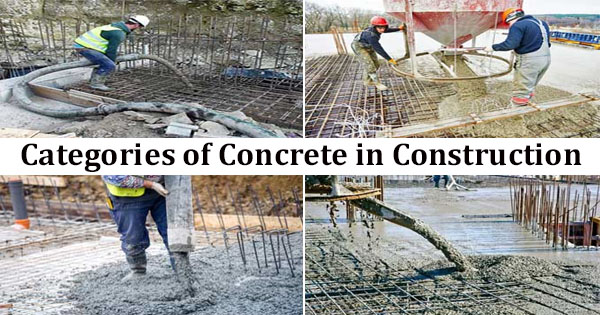Categories of Concrete in Construction

Given below, the detailed lists of some general and primary types of concrete :-
1. Normal concrete
2. High Strength Concrete
3. High Performance Concrete
4. Air Entrained Concrete
5. Light Weight Concrete
6. Self Compacting Concrete
7. Shotcrete
8. Pervious Concrete
9. Roller Compacted Concrete
1. Normal Concrete
- In this type of concrete, the common elements like aggregate, water, cement are utilized. It is also recognized as normal weight concrete or normal strength concrete.
- The setting time for this concrete type varies from 30 - 90 minutes on the basis of moisture in atmosphere, delicacies of cement etc.
- The progress of the strength begins after 7 days and the common strength values vary from 10 MPa (1450 psi) to 40 MPa (5800 psi). Within 28 days 75 - 80% of the total strength is obtained.
- Within 90 days 95% of the strength is achieved.
Properties of Normal Concrete
- Its slump differs from 1 - 4 inches.
- Density varies from 140 pcf to 175 pcf.
- It has good strength in compression and but poor strength in tension.
- Air content 1 - 2 %.
- Normal concrete does not last long toward arduous conditions like freezing and thawing.
2. High strength concrete
- Compressive strength of high strength concrete mix normally remains in excess of 6,000 pounds per square inch.
- High strength concrete is formed by reducing the water cement (W/C) ratio to 0.35 or lesser.
- Frequently silica fume is included to avoid the development of free calcium hydroxide crystals in the cement that make the concrete weaken in strength at the cement aggregate bond.
- Poor w/c ratios and the application of silica fume can considerably affect the workability of concrete mixes and it creates major issue in high-strength concrete applications where dense rebar cages are expected to be utilized. To manage the deflated workability in the high strength concrete mix, superplasticizers are generally included to high-strength mixtures.
- Be cautious in choosing aggregate for high strength mixes, as substandard aggregates have lower strength to withstand the loads enforced on the concrete and lead to failure in the aggregate.
3. High Performance Concrete
This mix contains the following properties:
- Superior Potency.
- Superior adaptability.
- Greater longevity.
- Trouble free placement.
- Compaction devoid of segregation.
- Premature age strength.
- Long-term mechanical properties.
- Permeability.
- Density.
- Heat of hydration.
- Toughness.
- Volume stability.
- Longevity in severe environments.
Development Process
High strength concrete mix is formed by choosing constituents cautiously and perfecting mix design.
- Superior performance is achieved with super plasticizers as they reduce the water cement ratio to 0.25 that is the necessary amount only for hydration process.
- High lastingness is contributed to fly ash and silica fume which rectify the geology of the cement; it improves the consistency of ingredients in concrete mass and lowers the CH amount. Fly ash also leads to ball bearing effect increasing adaptability.
- The admixtures are 20-25% fly ash of fractional replacement of cement and rest 70% is Ordinary Portland Cement.
- Air pulled agents can also be applied because it is not normally strong against freezing and thawing
Properties of high performance concrete mix
- Strength of high performance concrete differs from 10000 psi - 15000 psi
- Water cement ratio is minimized to 0.25
To read the complete article, click on the following link.
www.aboutcivil.org

